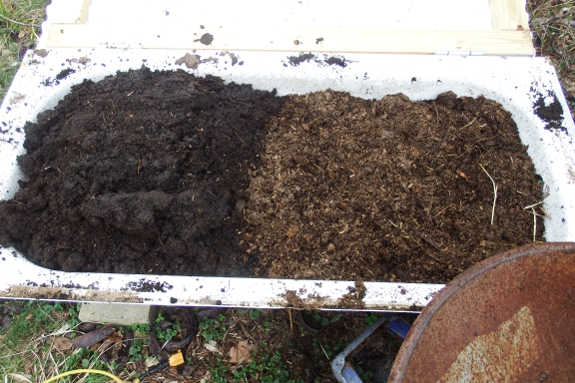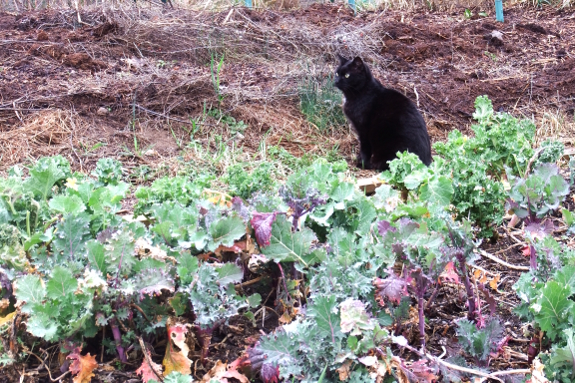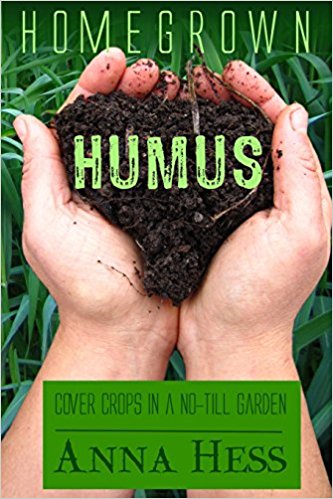
Homegrown Humus free (and garden update)
To give folks an easier entrance point to self-sufficiency, I enrolled
most of my books in Kindle Unlimited for the spring season. And one of
them --- Homegrown Humus --- is
free today!
This book, full of tips on improving your soil with cover crops, has
sold over 10,000 copies since it launched in 2013. If you've been
gardening for a while, you'll understand why. The idea of turning your
garden soil black through the application of a few seeds is like magic.
I hope you'll grab a copy and work some magic today.

Speaking of black gold, I finally delved into our two bathtub worm bins
to see how they fared over the winter. The bin we'd left alone had a
few large worms in it --- perhaps enough to recolonize the
half-composted manure by summer. The bin in which Mark had installed an
electric heat pad on low, though, was so full of worms of all ages that
we could have seeded a dozen more bins!
Since we don't have that infrastructure in place at the moment, I
instead raked the finished castings to one side and filled the other
half of the bin with semi-fresh horse-stall leavings. Hopefully the
worms will migrate over, leaving uninhabited castings for me to spread
on the garden in a few weeks. (I also scooped some of the worms over
into the other bin to get that composting process moving a bit faster.
Experiment is complete --- time to make double the black gold!)

March is the season when our garden really gets going, and this year's
coronavirus outbreak has made me more serious about the task than I
have been since our move. Luckily, the winter was mild, so a bit of
overwintering lettuce and spinach plus masses of kale are all available
to keep us healthy without hitting grocery stores.
Leafy greens do get boring after a while, though. That's why we have
new lettuce and peas coming up, lots of seedlings inside, and are
planting potatoes for the first time in quite a while.
Yep, potatoes. When I feel insecure, I stock up, and potatoes are an
easy way to ensure we'll have calories in a few months no matter what.
Plus, the more time I spend in the garden, the less I'm listening to
the news. Win-win!
Want more in-depth information? Browse through our books.
Or explore more posts by date or by subject.
About us: Anna Hess and Mark Hamilton spent over a decade living self-sufficiently in the mountains of Virginia before moving north to start over from scratch in the foothills of Ohio. They've experimented with permaculture, no-till gardening, trailersteading, home-based microbusinesses and much more, writing about their adventures in both blogs and books.
Want to be notified when new comments are posted on this page? Click on the RSS button after you add a comment to subscribe to the comment feed, or simply check the box beside "email replies to me" while writing your comment.


Hi Anna,
Did not find your free book....
Instead I found a clever link instead of a pdf.
2nd time this has happened. Recently I discovered archive.org's 'open' book is not really open.
It requires someone's online proprietary BS to even access the 'open' book.
Would you like to read a really free and very informative book about 'the flu'. Get on gutenberg and search for a book with the title 'the flu'. It has a lot of accurate unbiased information.
It is a very impressive work.
All, that said I really appreciate all the exceptional work you and your hubby have done.
For a little further help with staying healthy, I would recommend Sir Albert Howard's Soil and Health book. Also really free on journeytoforever.org in their farm library in the howardSH directory.
warm regards to you both. I hope we all survive this Chinese Military Virus.
John
Elaine --- The photos you're looking at are from our Virginia garden. We lived half a mile from the nearest road, so our best bet for aisles was just turning them into lawns via mowing whatever came up (mostly grass and clover). Here in Ohio, we're more accessible and have opted for wood chips...so far! I need to flag down another tree-trimming truck because our pile is now gone.
Of the two, wood chip aisles are definitely superior if you can get the mulch for free or cheap. Less work, not just in the mowing department but also in weeding encroaching plants in the sides of the garden beds. Plus, the mulch rots down into good soil that can be raked up into the bed!
Hi Anna!
My wife and I have been intensive composters and gardeners in Central Ohio for years. But I'm finally getting serious about using cover crops/green manures since we planted about 40 fruit trees (mostly apple) and about the same number of grape vines a few years ago. We're building a micro-cidery/winery. The soil in our apple and grape beds needed serious help, and since these are perennial plants, it made sense to keep cover crops always growing, dying, and being re-planted over the trees' and vines' root zones.
So I bought and read your book, 'Homegrown Humus' which I found enormously helpful. Some covers I've tried in the past were either inadequate at crowding out competing weeds or a pain to get rid of when they were no longer wanted. Your book helped narrow down cover crops to the most productive and easiest to manage. Now, in early August, I'm planning to plant a round of fall/winter covers. Last year I planted oats, which provided good coverage and reliably winter-killed, as you said it would. But I ran into the spring problem you referenced in your book. The beds were bare from late winter until May when I seeded a first round of buckwheat.
This year then, I'm thinking of planting winter rye. I've planted this green manure in the past on garden beds to keep them from being exposed over the winter months. But we found it necessary to turn under the rye with a spade in early spring in order to plant vegetables come May. Obviously, I want to avoid tilling the soil beneath our trees and vines. So I thought I'd write you to clarify what you seemed to be saying in 'Homegrown Humus'. If I plant rye this month and let it grow this fall, and then again next spring, it will die back, roots and all, when I cut it down with a weed whacker around the summer solstice? If so, can I plant another round of buckwheat at the time of killing the rye. It seems to me this would be necessary to get a stand of buckwheat down before planting another round of fall/winter cover next August.
Thanks in advance for any advice you can offer!
Yours, Craig Bickle and Lynn Taylor, Hap Woods Farm, New Guilford, Ohio
Craig --- Thanks so much for writing in with your experiences! It's fun to hear from another Ohioer now that we've moved to the Buckeye State.
To answer your question, yes, we've had good luck mow-killing rye once it hits full bloom. However, the stubble is really high in carbon and the roots will take a few weeks to die, so you likely won't have good luck planting anything into it immediately. Luckily, that also means the weeds shouldn't grow up in it immediately.
In your situation, I might try one of two different things. If the cover crop planting is close to the perennials' roots, I might toss down compost on top of the stubble to balance out the C:N ratio. If you want to go straight into buckwheat, you can broadcast the buckwheat seeds then lay the compost down over top and they'll come up through.
Option two: Wait. Give the dying rye a month, then plant.
Either way, I'd love it if you took some photos for us to share. Your experiment could help others in a similar boat.
Thanks for getting back! It takes me a bit to respond because I don't always have easy WiFi access... Anyway, my experience with winter rye becomes more intriguing by the season.
Regarding your suggestions, option one would take a lot of compost! We make our own and it's always coveted for other uses. Now, I put down about a half to a full wheelbarrow adjacent to each fruit tree in late winter/early spring along with a similar pile of ramial wood chips. The rest gets spread on the veg and flower beds. So I think I'll opt for your second suggestion, to just let the roots die in place. But here's the thing, it's now looking like rye could be a year-round cover crop!
We make our own and it's always coveted for other uses. Now, I put down about a half to a full wheelbarrow adjacent to each fruit tree in late winter/early spring along with a similar pile of ramial wood chips. The rest gets spread on the veg and flower beds. So I think I'll opt for your second suggestion, to just let the roots die in place. But here's the thing, it's now looking like rye could be a year-round cover crop!
I just hand-tossed rye seeds on my apple beds a couple weeks ago. I feel like this is a bit early for a fall/winter cover, but the buckwheat stand was mature and really needed to be pulled up and laid down. I'm loving how the action of re-seeding a new green manure crop after buckwheat accomplishes multiple tasks: plants the next cover, provides an opportunity to weed (easily and satisfyingly) what didn't get crowded out by the last round of growth, and creates a mulch on the soil surface. So I'm sold on at least one stand of buckwheat per year. But with winter rye, I'm wondering if that will be necessary... or even an option.
In two of my orchard sections, I planted rye at the beginning of August, like I said. One of the sections still has a lot of weeds I'd like to crowd out. I expect the rye will grow until November at which point dormancy will set in. Then, as I've experienced in the past, the stand will start to regrow in early spring and reach maturity sometime in June, at which point I'll whack it down and wait for the root thatch to disintegrate before laying down a new round of fall/winter cover... which takes me again to the beginning of August! Does that sound right?
At this point I'm committed to come what may. I'm wondering if I may feel the need to mow the rye at least once before winter sets in. And then how the roots will respond come spring. Regardless, the trees are relatively young and I didn't do a lot to prep the beds before I planted them. So I'll stick with a regimen of cover crops/green manures to improve the soil the feeder roots are growing into as the trees reach maturity. In my other two orchard sections I planted "torpedo" radishes. (That's what the Seed 'n Feed store called them.) So I'll be able to compare the two different covers this winter and next spring. I have pictures I can send you, but I can't figure out how to post them on Walden Effect. If you can suggest a way to get them to you, I'd be happy to share.
Yours, Craig